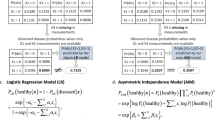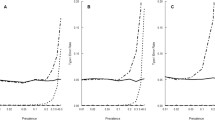Abstract
A common goal of epidemiologic research is to study how two exposures interact in causing a binary outcome. Sufficient-cause interaction is a special type of mechanistic interaction, which requires that two events (e.g. specific exposure levels from two risk factors) are necessary in order for the outcome to occur. Recently, tests have been derived to establish the presence of sufficient-cause interactions, for categorical exposures with at most three levels. In this paper we derive prevalence bounds, i.e. lower and upper bounds on the prevalence of subjects for which sufficient-cause interaction is present. The derived bounds hold for categorical exposures with arbitrary many levels. We apply the bounds to data from a study of gene–gene interaction in the development of Rheumatoid Arthritis. We provide an R-program to estimate the bounds from real data .
Similar content being viewed by others
References
Rothman K. Causes. Am J Epidemiol. 1976;104(6):587–92.
Rothman K, Greenland S, Lash T. Modern epidemiology. 3rd ed. Philadelphia: Lippincott Williams & Wilkins; 2008.
Källberg H, Padyukov L, Plenge R, Rönnelid J, Gregersen P, van der Helm-van A, et al. Gene–gene and gene–environment interactions involving HLA-DRB1, PTPN22, and smoking in two subsets of rheumatoid arthritis. Am J Hum Genet. 2007;80(5):867.
VanderWeele T, Robins J. The identification of synergism in the sufficient-component-cause framework. Epidemiology. 2007;18(3):329–39.
VanderWeele T, Robins J. Empirical and counterfactual conditions for sufficient cause interactions. Biometrika. 2008;95(1):49–61.
VanderWeele T. Sufficient cause interactions and statistical interactions. Epidemiology. 2009;20(1):6–13.
VanderWeele T, Vansteelandt S, Robins J. Marginal structural models for sufficient cause interactions. Am J Epidemiol. 2010;171(4):506–14.
Vanderweele T. Sufficient cause interactions for categorical and ordinal exposures with three levels. Biometrika. 2010;97(3):647–59.
Rubin D. Estimating causal effects of treatments in randomized and nonrandomized studies. J Educ Psychol. 1974;66(5):688–701.
Pearl J. Causality: models, reasoning, and inference. 2nd ed. New York: Cambridge University Press; 2009.
Sjölander A, Lee W, Källberg H, Pawitan Y. Bounds on causal interactions for binary outcomes. Biometrics. 2014. doi:10.1111/biom.12166.
Helmick C, Felson D, Lawrence R, Gabriel S, Hirsch R, Kwoh C, Liang M, Kremers H, Mayes M, Merkel P, et al. Estimates of the prevalence of arthritis and other rheumatic conditions in the united states: part I. Arthritis Rheum. 2008;58(1):15–25.
Efron B, Tibshirani R. An introduction to the bootstrap. New York: Chapman & Hall; 1993.
Liao S, Lee W. Weighing the causal pies in case–control studies. Ann Epidemiol. 2010;20(7):568–73.
Lee W. Completion potentials of sufficient component causes. Epidemiology. 2012;23(3):446–53.
Acknowledgments
Arvid Sjölander acknowledges financial support from The Swedish Research Council (340-2012-6007). Woojoo Lee acknowledges financial support from Basic Science Research Program through the National Research Foundation of Korea (NRF) funded by the Ministry of Education, Science and Technology (NRF-2013R1A1A1061332).
Conflict of interest
The authors declare that they have no conflict of interest.
Author information
Authors and Affiliations
Corresponding author
Electronic supplementary material
Below is the link to the electronic supplementary material.
Rights and permissions
About this article
Cite this article
Sjölander, A., Lee, W., Källberg, H. et al. Bounds on sufficient-cause interaction. Eur J Epidemiol 29, 813–820 (2014). https://doi.org/10.1007/s10654-014-9953-9
Received:
Accepted:
Published:
Issue Date:
DOI: https://doi.org/10.1007/s10654-014-9953-9




